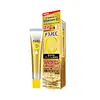What's inside
What's inside
 Key Ingredients
Key Ingredients

 Benefits
Benefits

 Concerns
Concerns

 Ingredients Side-by-side
Ingredients Side-by-side

Water
Skin ConditioningPropanediol
SolventPEG-40 Hydrogenated Castor Oil
EmulsifyingEthoxydiglycol
HumectantAscorbyl Tetraisopalmitate
AntioxidantPhenoxyethanol
PreservativeSargassum Filipendula Extract
Skin ProtectingHypnea Musciformis Extract
Skin ProtectingXanthan Gum
EmulsifyingFerulic Acid
AntimicrobialHydroxyethyl Acrylate/Sodium Acryloyldimethyl Taurate Copolymer
Emulsion StabilisingSodium Alum
AstringentGlycerin
HumectantSodium Acrylate/Sodium Acryloyldimethyl Taurate Copolymer
Emulsion StabilisingSclerotium Gum
Emulsion StabilisingLecithin
EmollientIsohexadecane
EmollientPullulan
Zinc Gluconate
Skin ConditioningCaprylyl Glycol
EmollientSorbitol
HumectantSodium Hyaluronate
HumectantPolysorbate 60
EmulsifyingEpigallocatechin Gallatyl Glucoside
AntioxidantAscorbic Acid
AntioxidantSorbitan Isostearate
EmulsifyingSilica
Abrasive1,2-Hexanediol
Skin ConditioningEthylhexylglycerin
Skin ConditioningSodium Benzoate
MaskingPotassium Sorbate
PreservativeGold
Cosmetic ColorantGlutathione
Water, Propanediol, PEG-40 Hydrogenated Castor Oil, Ethoxydiglycol, Ascorbyl Tetraisopalmitate, Phenoxyethanol, Sargassum Filipendula Extract, Hypnea Musciformis Extract, Xanthan Gum, Ferulic Acid, Hydroxyethyl Acrylate/Sodium Acryloyldimethyl Taurate Copolymer, Sodium Alum, Glycerin, Sodium Acrylate/Sodium Acryloyldimethyl Taurate Copolymer, Sclerotium Gum, Lecithin, Isohexadecane, Pullulan, Zinc Gluconate, Caprylyl Glycol, Sorbitol, Sodium Hyaluronate, Polysorbate 60, Epigallocatechin Gallatyl Glucoside, Ascorbic Acid, Sorbitan Isostearate, Silica, 1,2-Hexanediol, Ethylhexylglycerin, Sodium Benzoate, Potassium Sorbate, Gold, Glutathione
Butylene Glycol
HumectantPropanediol
SolventIsopentyldiol
HumectantPropylene Glycol
HumectantPEG-8
HumectantWater
Skin ConditioningAscorbic Acid
AntioxidantAlcohol
AntimicrobialPPG-6-Decyltetradeceth-30
EmulsifyingParfum
MaskingTocopherol
AntioxidantPyridoxine Hcl
Skin ConditioningAllantoin
Skin ConditioningO-Cymen-5-Ol
AntimicrobialAscorbyl Tetraisopalmitate
AntioxidantSodium Metabisulfite
AntioxidantAlpinia Katsumadai Seed Extract
Skin ConditioningDisodium EDTA
3-O-Ethyl Ascorbic Acid
Skin ConditioningAscorbyl Glucoside
AntioxidantSerine
MaskingCitrus Limon Fruit Extract
MaskingCitrus Grandis Fruit Extract
AstringentButylene Glycol, Propanediol, Isopentyldiol, Propylene Glycol, PEG-8, Water, Ascorbic Acid, Alcohol, PPG-6-Decyltetradeceth-30, Parfum, Tocopherol, Pyridoxine Hcl, Allantoin, O-Cymen-5-Ol, Ascorbyl Tetraisopalmitate, Sodium Metabisulfite, Alpinia Katsumadai Seed Extract, Disodium EDTA, 3-O-Ethyl Ascorbic Acid, Ascorbyl Glucoside, Serine, Citrus Limon Fruit Extract, Citrus Grandis Fruit Extract
 Reviews
Reviews

Ingredients Explained
These ingredients are found in both products.
Ingredients higher up in an ingredient list are typically present in a larger amount.
Ascorbic Acid is is pure Vitamin C. This form makes up the largest amount of vitamin C found naturally in our skin.
Not only is vitamin C great for your overall health and immune system, it also has plenty of benefits on your skin.
Vitamin C is best used for brightening skin. It improves dark spots, acne scars, and hyperpigmentation. This is because it blocks the process of skin darkening when exposed to UV.
Remember: Vitamin C should not replace sunscreen!
Your skin uses vitamin C to build collagen. Collagen is one key component in having a strong skin barrier and plump skin. Vitamin C also plays a role in regulating collagen, thus making it effective in improving wrinkles and fine lines.
Ascorbic acid shows potent antioxidant activity. As an antioxidant, it helps fight free-radicals. Free-radicals are molecules that may damage your skin cells. These antioxidants also protect skin against UV damage.
The best formulations include Vitamin E and/or ferulic acid. These two ingredients help stabilize and provide a boost in the benefits of ascorbic acid. This is because ascorbic acid becomes unstable when exposed to UV and air. In fact, you can tell your ascorbic acid has oxidized when it turns an orange-yellow color.
Ascorbic acid is generally compatible with other ingredients. However, using ascorbic acid with other active ingredients might cause irritation. Two ingredients: copper ions and benzoyl peroxide, will inactivate ascorbic acid completely.
Read more about other types of Vitamin C:
Foods rich with vitamin C include oranges, strawberries, broccoli, bell peppers, and more. When consuming Vitamin C, your skin receives a portion of the nutrients.
Learn more about Ascorbic AcidAscorbyl Tetraisopalmitate is a version of ascorbic acid, or Vitamin C.
This ingredient has many benefits including reducing wrinkles, skin soothing, dark spot fading, and fighting against free radicals.
It helps with dark spot fading by interfering with the process of skin darkening, helping to reduce hyperpigmentation. Like other forms of vitamin C, this ingredient encourages the skin to create more collagen.
As an antioxidant, it helps fight free-radicals. Free-radicals are molecules that may damage your skin cells.
One study found Ascorbyl Tetraisopalmitate to degrade in sunlight, but is stabilized when combined with acetyl zingerone.
Learn more about Ascorbyl TetraisopalmitatePropanediol is an all-star ingredient. It softens, hydrates, and smooths the skin.
It’s often used to:
Propanediol is not likely to cause sensitivity and considered safe to use. It is derived from corn or petroleum with a clear color and no scent.
Learn more about PropanediolWater. It's the most common cosmetic ingredient of all. You'll usually see it at the top of ingredient lists, meaning that it makes up the largest part of the product.
So why is it so popular? Water most often acts as a solvent - this means that it helps dissolve other ingredients into the formulation.
You'll also recognize water as that liquid we all need to stay alive. If you see this, drink a glass of water. Stay hydrated!
Learn more about Water